One thing I remember about the brickworks in Dogsthorpe is the buckets see below, which used to go along cables between Eye and Dogsthorpe, to get the clay from the pit to the works I suppose. I came across this picture of them. I am guessing that the buckets served the London Brick works which were on the site of the householders waste site, as my memories date from the sixties.
There has been a tradition of brickmaking in the Peterborough area from at least the eighteenth century, these were small yards operating seasonally and using the more superficial clays. From the 1880's onwards experimentation with the lower Oxford Clay allowed the mass-production of bricks on an industrial scale. Hence the rapid formation of several companies all competing to exploit the new process, and many of smaller companies were bought up.
 The brickworks on the 1889 map, to the north of Welland Road, were owned or occupied by Thomas Parker and family from 1872 up to 1897. It was possibly previously occupied by Edward Vergette of Peterborough in the 1860’s.
The brickworks on the 1889 map, to the north of Welland Road, were owned or occupied by Thomas Parker and family from 1872 up to 1897. It was possibly previously occupied by Edward Vergette of Peterborough in the 1860’s.
The site was possibly occupied by George Cursley from c 1890 to 1897. The 1891 census shows him as a Brickmaker and an employer, living in Dogsthorpe:
George Cursley 40 living with his wife Louisa 30, both born in Bedford. There are six children between the ages of 11 and 1, helping us to trace their movements. The eldest Thomas 11, was born in Sleaford; Arthur 9,Nelly 7, and Anne 5, were born in Burton Awardine, Lincs; Louisa 3, was born in Peterborough; but only Edith 1, was born in Dogsthorpe. Which supports the suggestion that they had the site from 1890.
The site was sold in 1897 to John W Rowe who formed the Dogsthorpe Brick & Tile Co Ltd. The site was put up for auction but not sold in February 1899, it’s subsequent history is unknown.
The remaining kiln was demolished about 1942/3. The land was acquired by Peterborough City Council and was used first as a rubbish tip and then for a recreation ground and still remains to this day, see below.
Dogsthorpe Star Brick Co., brickmakers of Dogsthorpe, Peterborough. The company was incorporated in 1913 and it bought the Star Pressed (Dogsthorpe) site in 1915. It was owned by the same family who owned the London Brick Co. Ltd., and it was formally taken over by London Brick in 1923/4.
The London Brick Company was founded in Fletton, Peterborough, by businessman J C Hill in 1889. It went on to dominate the British brick industry for most of the 20th century.
In 1997 ownership of Dogsthorpe Star Pit was transferred to the Wildlife Trust. Water was pumped out of the pit to restore the shallow pools so important for wildlife. Footpaths have been installed to guide you around some of the reserve’s many different habitats. Over the road is Little Wood, an area of ancient woodland with large pollarded oaks and a ground flora of bluebells.
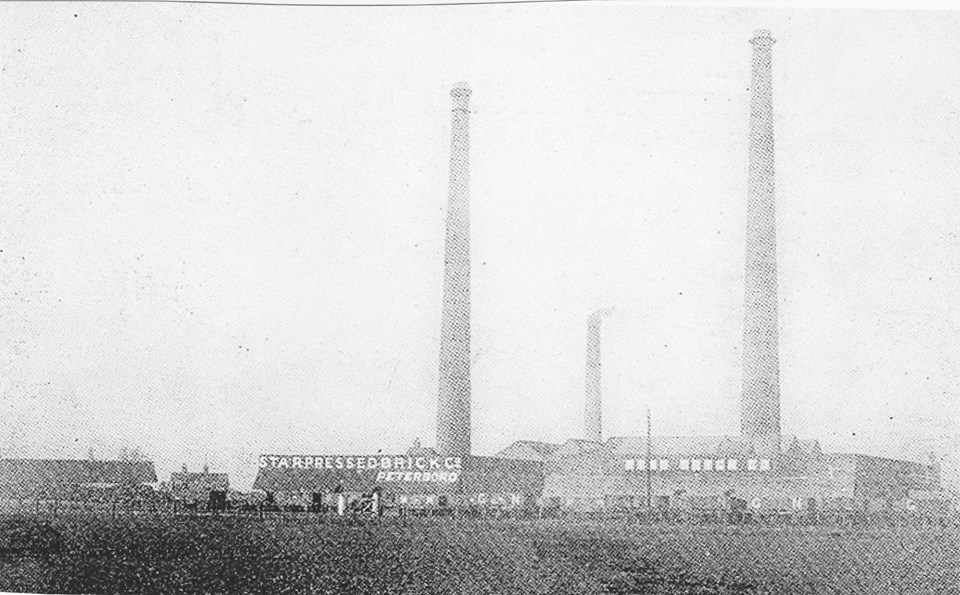
The Brick Making Process
Historically the basic process of brick making consisted of digging out clay in the winter, allowing it to weather, then feeding it to a pug mill to mix it with other ingredients (such as chalk or sand). The actual bricks were moulded during the summer - an Act of Parliament only allowed this to occur from March to October, as the quality of bricks made in winter was poor, for the clay needed to dry before being used. The moulder - in charge of a team of 6 men - could make maybe 1000 bricks per hour by hand, and these ‘green’ bricks were left out to dry for several weeks before being fired in a kiln. The correct firing conditions was the key to success. The earliest firings were done by heaping the bricks and fuel together and covering with turf, but simple kilns followed - a single ‘clamp’ of a brick arch covered with turf being one of the earliest, followed by round brick kilns. These were not fast enough, however, and various other styles were developed to give a continuous process. Another innovation to speed up brickmaking was the development of machine extrusion of the clay, which had only to be cut into brick sized lengths.
The “Fletton” process was invented in Fletton, Peterborough in 1891. Fletton bricks are made from Lower Oxford clays: this type of clay has certain qualities of stiffness which enable it to be “stamped” into the shape of a brick under high pressure. As such, the process uses clay “straight from the ground” with no processing and no added water. The “green” or unfired bricks are therefore placed in the kilns with no pre-drying. In addition the clay, having high carbon content, is able to provide most of the heat needed to burn the bricks – only 25% being supplied externally. The process is also particularly easy to automate because the bricks produced are all of precise size and shape.
For these reasons, bricks made using the Fletton process are particularly cheap to produce. However, this cheapness is at the expense of the external appearance of the brick, and its ability to withstand great external stresses.
Some more information about the Brick Works at Dogsthorpe courtesy of Peterborough Garden Park's website
Brick making, railways, and a sports field are part of the more recent history of this site at Dogsthorpe, formally a hamlet outside Peterborough.
On August 1st 1866, the Midland and Great Northern Railway opened a line from Peterborough to Dogsthorpe, Eye Green, Thorney, Wisbech, Kings Lynn, Melton Constable and Great Yarmouth, with a branch line to Hunstanton and Her Majesty the Queen’s Estate at Sandringham. The line ran through the then village of Dogsthorpe – agricultural parish land at the time.
Part of that land was purchased in the late 1880’s by a private brick company, one of several around Peterborough, well known for the brick making qualities of its clay soil. At the Dogsthorpe Works two draglines were used to excavate the clay which was then taken by a conveyor into the works where a two-shift system was operated that produced almost 750,000 bricks each week. These were all Tudor facings, due to the red clay being ideal for this type of brick.
The Dogsthorpe Works had three Hoffman kilns, each able to take fork lift trucks and the Dogsthorpe pit also supplied clay to the Northam Works with the clay being transferred over a mile by an aerial bucketed ropeway. Following production the majority of the bricks were transferred from Dogsthorpe by the M&GN railway line to all parts of the country. The Dogsthorpe Siding was adjacent to where Peterborough Garden Park is today and the line was taken out of service in 1966.
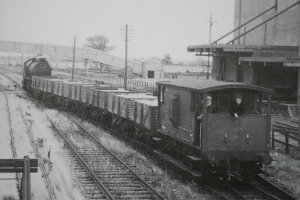 For brick making purposes the quality of the clay on the Garden Centre part of the site was not as good as the land adjacent to it. Consequently the brick works used part of the site to deposit surplus clay which had been excavated from other parts of their site, but was not of sufficient quality for use.
For brick making purposes the quality of the clay on the Garden Centre part of the site was not as good as the land adjacent to it. Consequently the brick works used part of the site to deposit surplus clay which had been excavated from other parts of their site, but was not of sufficient quality for use.
An amalgamation of all the private brick companies in Peterborough, including the Star Pressed Brick Company at Dogsthorpe, took place in 1922, when the London Brick Company took over the brick works land including the part on which the Garden Park now sits.
The London Brick Company, in the late 1990’s when they stopped producing bricks, used the resultant deep craters for landfill and received planning approval for retail and other uses.
An article from
Peterborough Advertiser - Wednesday 16 November 1898
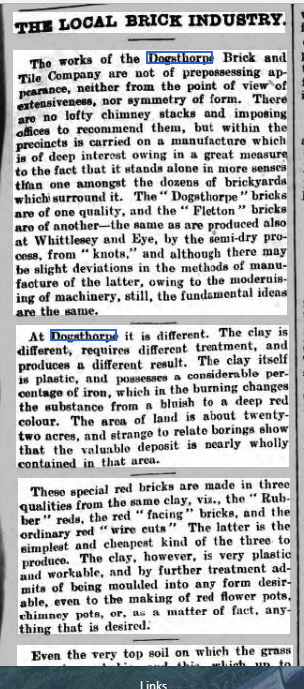

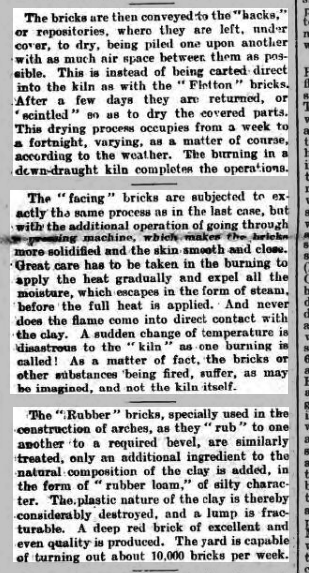
Thanks to Rita Cowdell for the following gems.
Welland Rd Recreation Ground
The charred stock from the major fire at Sayles Department store in 1956 was all dumped in the tip in Welland rd Dogsthorpe and all us kids used to go searching through it to see if we could find a pair of matching high heels.
There was a big pond in the middle where we used to go Tadpoling
Once they had filled in the tip they built a row of council houses on the front of it on Welland Rd which would be about 1958 and the Rec was behind them. I lived on Welland Rd in three different farm cottages no's 24, 38 and 74 first two were demolished to make way for new builds.
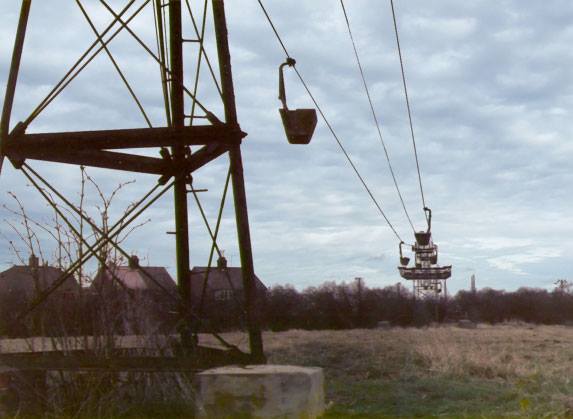
The final day of Dogsthorpe chimneys 14/6/1991. I guess the photo was taken from the building next door.
